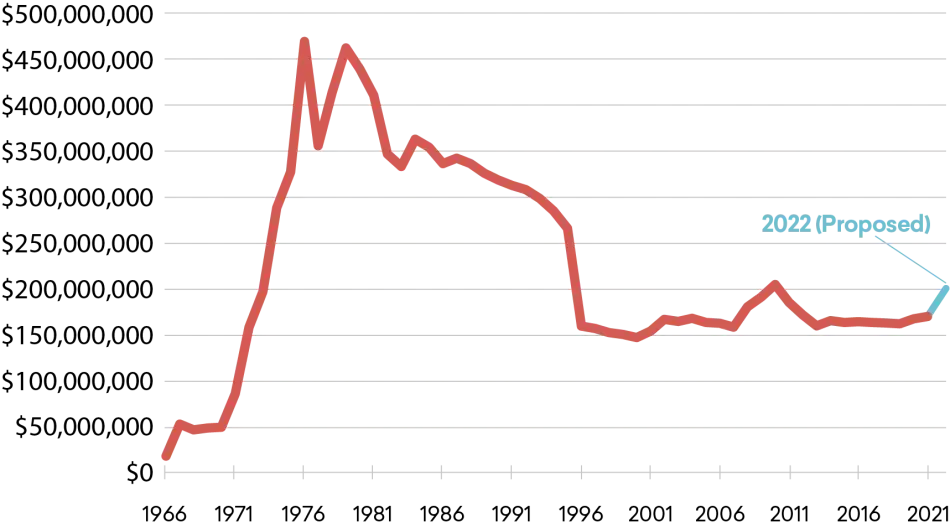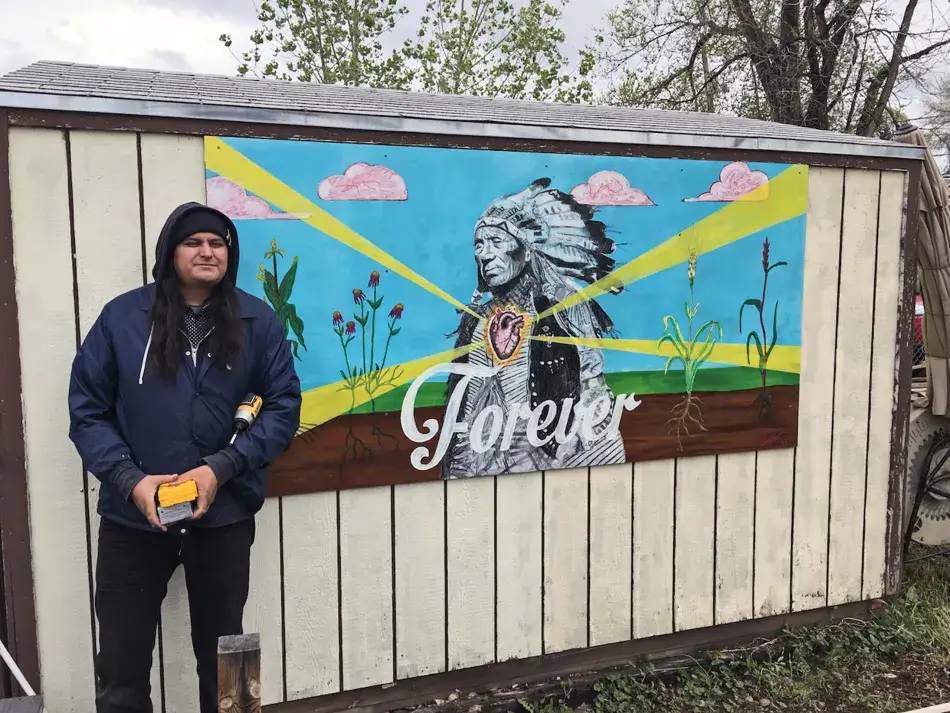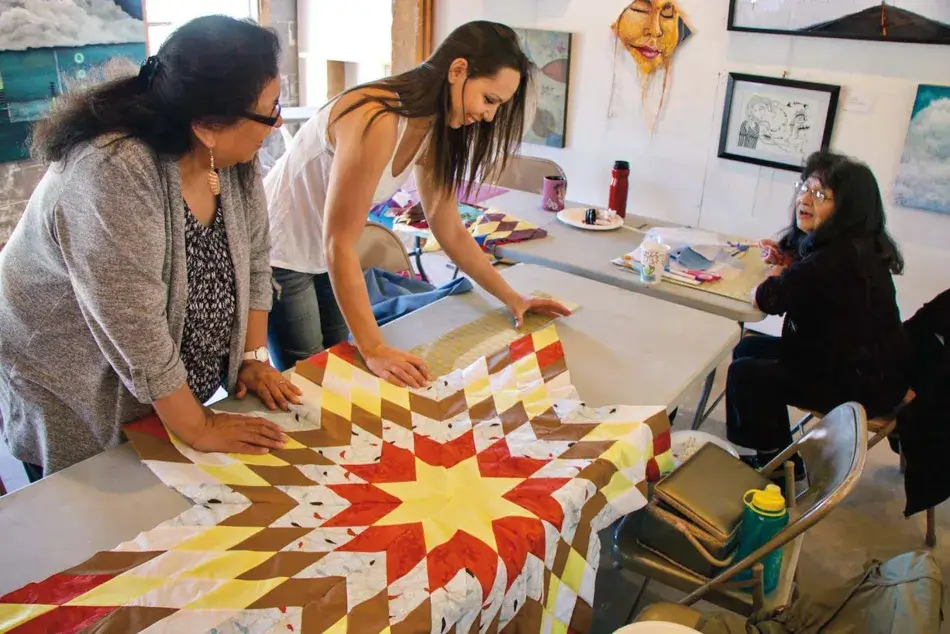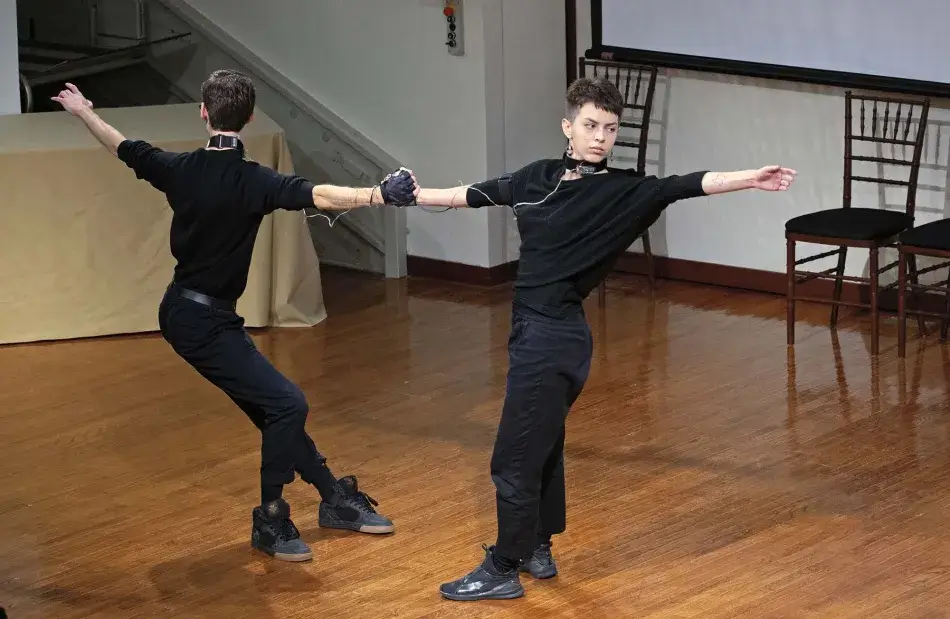The Principles and Recommendations
In our research, listening sessions, and conversations with advocates and experts, four key principles arose repeatedly as priorities for the future: 1) Name and include artists in federal policy; 2) Recognize how creative work happens; 3) Center equity; and 4) Think locally, share nationally. These principles shaped and guided the recommendations developed by the Academy’s Commission on the Arts.
Name and Include Artists in Federal Policy
Despite artists’ manifest economic and social value, national surveys show the public generally fails to recognize that value. A similar problem holds true in policy. If they are not explicitly named and included in legislation and regulation, the creative sector and artists are often forgotten or excluded from economic and workforce development. Currently, federal funding and programs that could be used to support the creative sector and/or artists depend on local administrators and artists who not only are aware of the problem but are willing to facilitate these goals. Likewise, when artists do not have a voice at the table, their contributions and needs fall by the wayside. As a result, federal legislation must specify that the creative sector and artists are eligible for a variety of programs—and then make sure that administrators, organizations, and artists know about them. During the present crisis and beyond, this work also needs to be adequately funded. This can be achieved both through the inclusion of artists in overall workforce programs and through the provision of programs specifically aimed at artists (such as the recently introduced 21st Century Federal Writers Project).
Naming and Inclusion Recommendations
Create a position for a senior advisor on the arts at the executive level (Federal—the White House)
The time for an appointed representative of the arts and culture sector in the senior ranks of the federal government is long overdue. The arts play a vital role in the health of the nation at home and abroad. Yet they are not formally represented anywhere in the vast White House staff, despite a long history of calls for such representation. Similar posts exist in more than fifty other nations, such as Australia, South Africa, and the United Kingdom.44 We recommend the creation of a senior White House advisor on the creative economy.45 This advisor could ensure that arts and the creative economy are considered in federal policy, as well as coordinate the programs and policies distributed across the various federal agencies, making sure that the value of arts and artists is truly integrated into national planning.
Name and include the creative sector and artists (Federal agencies and departments)
While artists and creative workers may be eligible for many federal programs, such as workforce development, adult education, small business support, and community development block grants, their eligibility is often ambiguous and thus depends on advocates to make sure the local agencies implementing programs are aware of it. This leads to gaps and inconsistencies across the country. We recommend that language specifically naming either “the creative industries,” “arts and culture,” and/or “creative occupations” is added to legislation. Both the proposed CREATE Act and PLACE Act offer models of how and where this language might be added (for instance, by adding “creative industry or occupation” to the Workforce Innovation and Opportunity Act).46
The Arts in Emergency
Artists and arts organizations are often central actors in disaster recovery, as arts consultant Amy Schwartzman told us. Yet, Federal Emergency Management Agency (FEMA) programs often exclude artists both from recovery assistance and from taking roles in mitigation and recovery efforts. Various restrictions, lack of awareness, and cumbersome application processes prevent many organizations and individuals from accessing FEMA relief funds.47 For example, most artists and arts organizations report not being able to access funding designated for “cultural resources” in the National Response Framework and the National Disaster Recovery Framework.
Artists have much to offer the country’s disaster preparedness and recovery systems. Artists’ skills in communicating to wide audiences, improving community spaces (such as shelters), and offering outlets for social and emotional expression and reflection are invaluable in disaster response. Moreover, the local nature of many disasters requires deep community insight, something artists and arts organizations are often well-equipped to provide. Integrating—and compensating—creative workers into disaster preparedness, response, and recovery through partnerships between government actors and cultural groups would facilitate greater economic and social resilience. As stated by Amelia Brown, artist and activist, “We live in times that need solutions to the rapidly growing number and type of emergencies. To plan and respond effectively, we need to look at art as an integral part of solutions that can repair community trust as well as infrastructure.”48
Currently, artists and the creative industry are not eligible for support from several critical programs. That must change. For instance, FEMA should be able to provide direct assistance to artists and culture workers following a disaster. Likewise, proposed legislation such as the STAR Act could reenable previous flexibility to allow federally funded local transit projects to include art in their infrastructure investments.49
Finally, the inclusion of artists and cultural leaders on federal advisory boards and commissions could help ensure that artists are considered in any programs and decision-making. The creation of a taskforce on the creative workforce, housed at the Department of Labor, could be an opportunity to innovate around the future inclusion of artists and creative workers.
Figure 2: Federal Appropriations for the National Endowment for the Arts, 1966 to 2022 (adjusted for inflation)

Source: National Endowment for the Arts’ Appropriations History and the President’s Budget Request for FY2022, adjusted for inflation using the GDP (chained) price index.
Increase Funding for the Arts (Federal)
Federal funding is essential to supporting artists. We recommend an increase in funding that supports creative workforce development in order to enable and expand the benefits to artists. Funding for institutions that support and sustain artists may come from several directions (some of which are addressed in more detail in later recommendations), including the National Endowment for the Arts (NEA), the Small Business Administration (SBA), and the Department of Education. The NEA’s FY2021 budget is $167.5 million, only 0.004 percent of the total federal budget, amounting to just 49 cents per capita. This budget has not kept up with inflation and has gone down significantly since a peak in 1979.50 Funding at a national level is largely passed on to states, jurisdictions, regional agencies, and tribal nations and thus is an essential component of funding for local artists. The $33.5 million increase proposed in the federal FY2022 budget is an important step in the right direction.51

Include Artists in Projects of Recovery (Federal and state)
Finally, we recommend not just that recovery assistance be directed to artists but that artists also be included in projects of recovery. Given the outsize impact of the pandemic, the arts and culture sector will be one of the slowest to recover. Artists and creative workers will need continued assistance to ensure they are not lost from the industry. Artists can also be of great value to programs of recovery and building resilience.52 At the federal level, directed programs (such as the Shuttered Venue Operator Grant or the proposed 21st Century Federal Writers Project) are one way to support the creative industry and involve artists in the national recovery. Education for local governments is needed to ensure broad understanding of the many ways artists and creative workers can be incorporated into local relief and recovery efforts.53
Recognize How Creative Work Happens
Many workforce development programs, labor protections, and safety-net provisions fail to account for the ways artists actually work today, when many are more akin to independent contractors and small businesspeople than full-time employees. Federal, state, and tribal programs and policies need to support lifelong learning and entrepreneurship by artists, as well as protections that enable them to take the artistic and financial risks necessary to sustain a thriving creative workforce. Many of the protections needed by artists are provided by programs that do not specifically target that particular workforce. For instance, Alexis Frasz, codirector of Helicon Collaborative, told us that “the intervention that has perhaps most benefited artists in recent years—the Affordable Care Act—was not a grant program at all.” Since artists are more likely than the general workforce to be self-employed and often hold multiple jobs, building a steady floor of access to health care, childcare, and retirement savings that is not tied to a full-time employer will enable the growth of a vibrant and well-supported creative workforce.
In addition, while the question of misclassification of workers is a complicated one, the extension of many protections now tied to the employee/employer relationship (e.g., health and safety protections, unemployment insurance, protections against discrimination and harassment) would benefit artists and others in the gig economy.54 For instance, the performing arts have a relatively high incidence of work-related nonfatal injury and illness.55 Yet those working as independent contractors are not eligible for protection under OSHA, nor are they entitled to worker’s compensation.
“Just like other small business owners and independent workers, artists often operate without a safety net and within systems that extract and devalue their labor. With our eyes firmly on dismantling these systems and rebuilding something better, we need new protections for creative workers and new support for creative small businesses. We need broad and robust support for local programs that support, train, and sustain artists and culture bearers and their communities, so they can work on imagining and building a future that values individual and community needs not only for safety, security, and health but also for meaning, connection, and love.”
—Laura Zabel, Commission member, Executive Director of Springboard for the Arts
Creative Work Recommendations
Increase workplace protections for independent workers (Federal, state, and municipal)
As a starting point, we recommend that independent workers be given access to the same protections enjoyed by other workers against harassment and discrimination and against health and safety hazards in the workplace. This could be accomplished at the federal level by including independent contractors and interns in protections such as the Civil Rights Act, the Equal Pay Act, and the Americans with Disabilities Act (as indicated in proposed legislation such as the BE HEARD Act).56
We also recommend the creation of new systems for two key benefits: unemployment insurance and pensions/retirement savings. The Pandemic Unemployment Assistance program made unemployment assistance available (with numerous challenges) to many artists and contract workers for the first time. Yet this is not a permanent change. Broadening access to both unemployment insurance and pensions could be accomplished through the creation of portable benefits systems, which could also include other benefits currently funded in whole or part through employers, such as paid leave. Alternately, self-employed workers could be allowed to opt in to traditional unemployment insurance.57

Provide greater access to small business resources (Federal, state, and tribal nations)
Many artists are running small businesses, producing their art for sale, or contracting out their artistic labor. They need access to resources, both educational and financial, to grow their businesses. Yet accessing loans and other financial services can be a challenge for artists, as many services are not designed with their unique needs in mind.58 Incubators and accelerators can be one resource, as they often provide new businesses and nonprofits with fiscal sponsorship, facilities, and business assistance.59 Community development banks and similar financial institutions can also be an important resource, especially in Native communities.60 At a federal level, this could consist of ensuring that artists have greater access to general programs for economic development, or it could mean targeting programs specifically to artistic businesses through the Small Business Administration, as well as the Departments of Commerce and Agriculture.61 To do this, existing programs must be adapted to the needs of solo entrepreneurs and micro-enterprises that are often excluded from such programs.62
Expand artist training (Universities/colleges, workforce development agencies, and nonprofits)
Workforce development training would benefit both from greater coordination among agencies (such as Workforce Boards, the Department of Education, and the Supplemental Nutrition Assistance Program) and from a greater focus on lifelong learning. Workers today are often required to obtain training not just at the beginning of their career but throughout it.63 Training for artists currently happens informally through mentorships, apprentice-like relationships, and in the community, as well as formally through university and college programs, for-profit programs, programs run by nonprofits, and through municipal and state arts agencies and departments. We recommend coordination of training among organizations and the expansion of programs that also train non-arts employers to work with artists.64 The range of training should include not only essential skills in the craft but also skills such as entrepreneurship and community engagement.
“There has been much hand-wringing about finding gainful employment for writers, as for other artists; that should not end. But we might also think about simply paying writers for the work they are already doing. As of now, ‘exposure’ and book sales are imagined to be payment enough even when an event organizer is charging admission and the author is its headline draw, never mind that said author typically nets $3.50/hardcover book. How about making honoraria a standard line item in all event budgets, starting with the National Book Festival?”
—Gish Jen, Commission member, novelist
Reinforce a steady floor (Federal, state, and municipal)
Since artist income can be variable and subject to underpayment and abrupt loss of earnings, a steady floor is essential to the success of this workforce. Partly as a result of the pandemic, efforts are growing at the city level for a guaranteed income, and artists have been included as beneficiaries.65 For instance, as an addition to the city of St. Paul’s monthly guaranteed income pilot program, Springboard for the Arts launched a pilot for arts and culture workers.66 Small-scale pilot programs have shown that a guaranteed monthly stipend, usually of a relatively small amount such as $500, can raise levels of full-time employment as well as financial, physical, and emotional health.67 These programs recognize how a counterbalance to fluctuating income, a staple of the gig economy, can allow workers to build futures. This is necessary to ensure that participation in the artistic workforce is not reserved for those with generational wealth but is open to all with the aptitude and inclination to pursue a life in the creative workforce. Such programs also have the potential to generate community impacts well beyond the recipients of the guaranteed income, as artists who have a more stable economic footing have more time to generate neighborhood- and community-focused work.

Center Equity
Historically, the arts and culture field has been plagued by issues of inequity along economic, racial, and gender lines. Not every kind of art has been considered “real” art, nor has every kind of person been considered a suitable artist. At various periods in our history, Indigenous arts were suppressed.68 While Black musicians have created art essential to American music today, they have not always been able to profit from that work.69 The majority of cultural philanthropy goes to large institutions, primarily focused on the Western European fine arts tradition, while smaller organizations and those focused on culturally specific groups are underresourced.70 Just 11 percent of all recent acquisitions at prominent U.S. museums were of work by female artists.25 Female arts graduates and arts graduates of color are less likely than male arts graduates (of all races) and white arts graduates (of all genders) to stay in arts-based occupations.72
As we rebuild the creative economy, we must renew our efforts to dismantle racist and sexist aspects of the current system, work to include and fund BIPOC artists at all levels, and fund arts and culture organizations run by BIPOC leaders. Funding streams and training pathways, including paid internships and apprenticeships, are essential to creating a more equitable system. An overreliance on unpaid internships and other undercompensated and unstable employment models creates persistent inequities in who can enter the cultural field with any measure of stability, especially given that those who have been able to do an arts-related internship are more likely to stay in the field.73 Arts graduates with debt over $50,000 were less likely to stay in arts-based occupations, and (revealingly) a 2013 study showed that Black and Latinx arts graduates were more likely to have college debt.74 Overall, financial access to many kinds of training (including both higher education and ongoing training such as the consistent lessons many professional singers undertake) is a barrier to a more racially and ethnically diverse artistic workforce.75
The extension of worker protections could enable more artists to stay in the field once they enter by reinforcing more sustainable and equitable employment. Currently, many federal protections against sexual harassment and racist discrimination, as well as access to disability accommodations, are not available to independent workers.
Centering equity also means locating decision-making power with BIPOC artists and organizations. A recent report on a national Native Arts and Culture convening emphasizes the need for more Native power in policy-making and institutions, as well as the benefit that Native-led arts and cultural organizations can have for Native artists and culture bearers.76 A study of high-performing arts organizations of color shows how, in the face of challenges such as racism, gentrification, and lack of access to institutional funding, they have achieved success by connecting a community orientation with high-quality programs.77 Organizations like these are essential for artists of color, and many were created because of the lack of opportunity for those artists. Unfortunately, they are also constrained by issues of funding and compensation.78 For tribal nations and arts organizations of color that have been systematically underresourced, support and funding are necessary to enable the expansion of infrastructures to grow creative careers. Rather than directing funding meant to increase diversity in the arts toward organizations not primarily oriented toward communities of color, funding must be provided directly to those communities.79
Centering Equity Recommendations
Fund and support apprenticeships and training pathways (Workforce development, universities/colleges, and the arts and culture industry)
Supporting entryways into creative work is one way to diversify the workforce. Given the value of lower debt for retention in the arts sector, funding these entryways could also be helpful in allowing artists to remain artists once they begin a career in the field. One avenue is to subsidize tuition at Historically Black Colleges and Universities (HBCUs), Tribal Colleges and Universities (TCUs), and other minority-serving institutions.80 We also recommend strengthening and expanding apprenticeships and paid internships specifically aimed at artists of color, women artists, nonbinary and transgender artists, and artists with disabilities. Arts2Work, the City University of New York’s (CUNY) Cultural Corps program, and LA County’s Arts Internship Program are all examples of programs aimed at bringing underrepresented artists and creative workers into the system.81 This requires coordination among the arts and culture industry, colleges and universities, philanthropy, and government (whether city, state, tribal, or federal).

Design grant and position application processes for greater equity (Funders, government, and the arts and culture industry)
Equity efforts need to focus not just on training but also on enabling diverse artists to move forward in their careers, by reevaluating grant and prize processes and job application processes. Job and grant applications should acknowledge that artists enter the arts through various channels and should not require an MFA (or similar degree). We recommend straightforward applications for both jobs and grants and straightforward (or reduced) reporting for grant funding. Prioritizing grant and prize committee diversity can also help displace artistic norms that center notions of excellence only on Western European fine arts traditions.82
Increase funding to TCUs, HBCUs, and arts organizations of color (Federal, universities/colleges, and philanthropy)
Funding must be directed to organizations and institutions run by and for Black, Indigenous, Latinx, and Asian artists and communities. This could be done through the NEA, the Department of Education (and the Bureau of Indian Education), and other federal agencies (with recognition that, for tribal nations especially, this must be done under their guidance). Philanthropy also has a role to play through individual grants and multi-funder initiatives such as America’s Cultural Treasures, led by the Ford Foundation, which offers financial support to Black, Latinx, Asian, and Indigenous arts organizations.83 Assuring that these organizations are fully included in the available funding streams for the arts will play a vital role in breaking down some of the demographic inequities in the system.
